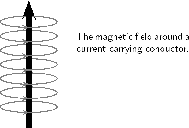| << Chapter < Page | Chapter >> Page > |
Electromagnetism describes between charges, currents and the electric and magnetic fields which they give rise to. An electric current creates a magnetic field and a changing magnetic field will create a flow of charge. This relationship between electricity and magnetism has resulted in the invention of many devices which are useful to humans.
If you hold a compass near a wire through which current is flowing, the needle on the compass will be deflected.
Since compasses work by pointing along magnetic field lines, this means that there must be a magnetic field near the wire through which the current is flowing.
The magnetic field produced by an electric current is always oriented perpendicular to the direction of the current flow. Whenwe are drawing directions of magnetic fields and currents, we use the symbols and . The symbol
represents an arrow that is coming out of the page and the symbol
represents an arrow that is going into the page.
It is easy to remember the meanings of the symbols if you think of an arrow with a head and a tail.

When the arrow is coming out of the page, you see the point of the arrow ( ). When the arrow is going into the page, you see the tail of the arrow ( ).
The direction of the magnetic field around the current carrying conductor is shown in [link] .


Using the directions given in [link] and [link] try to find a rule that easily tells you the direction of the magnetic field.
Hint: Use your fingers. Hold the wire in your hands and try to find a link between the direction of your thumb and the directionin which your fingers curl.

There is a simple method of finding the relationship between the direction of the current flowing in a conductor and the directionof the magnetic field around the same conductor. The method is called the Right Hand Rule . Simply stated, the right hand rule says that the magnetic field lines produced by acurrent-carrying wire will be oriented in the same direction as the curled fingers of a person's right hand (in the "hitchhiking"position), with the thumb pointing in the direction of the current flow.

Notification Switch
Would you like to follow the 'Siyavula textbooks: grade 11 physical science' conversation and receive update notifications?